Fire Drill/Practice
Beaver River Property Owners Assn., Beaver River Station, NY – Community Safety
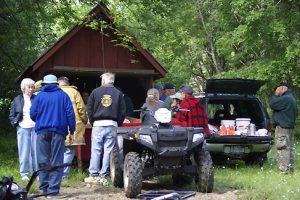
Camp owners gather at the Beaver River Fire “Barn”. The barn is located by the north railroad crossing, right next to the tracks. The ATV is used to pull the fire equipment trailer.Because the hamlet of Beaver River Station is not covered by a fire district, it’s up to the residents and camp owners to try and save what they can in the event of a fire. Periodic fire practices such as this are held so that everyone has some familiarity with the equipment and procedures. Camp owners who are not trained firefighters should never enter a burning building. Instead, the focus is on suppressing the fire from the outside and making sure that surrounding vegetation doesn’t burn so that nearby camps and forest are not at risk.
Although these photos can give you some idea of what’s involved, they can’t come close to an actual hands-on experience. If you own property in Beaver River and it’s been awhile since you’ve attended one of these practices, you are encouraged to do so the next time one is scheduled. You DO NOT have to be a member of the BRPOA to attend. Who knows? The camp you save may be your own.
(And note the free coffee and donuts in the back of the SUV!) |

Led by “real-life” volunteer firefighters & camp owners Ron Nearing and Dick Williams, attendees receive a short orientation to the equipment that’s permanently stored on the trailer.
|

Volunteer firefighter and camp owner Tom Brown heads for the bridge with the fire trailer in tow. Pump #1 can be seen in the center along with fire hose on the left. Additional fire hose is stored on the right side, under cover.
|
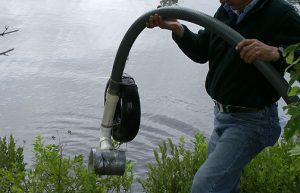
The water intake is a home-made device that’s actually quite effective. The tire keeps it afloat and duct tape keeps the screens on the ends to prevent sediment from entering the pump.
|
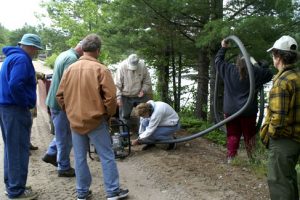
Pump #1 has been taken off the trailer and the intake hose is being connected by Ruth Phelps while Pat Oberman prepares to toss the water intake into the pond.
|
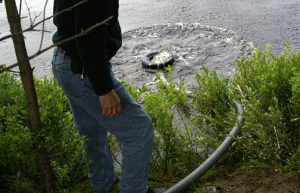
The water intake is tossed into the pond. The water needs to be a foot or more deep and the intake must land in the correct orientation, with the tire on top and the intake below.
|

The gray hose is the water intake. To keep the pump from sucking any air, the green collar must be tightened with a wrench (not shown) that is permanently kept on the equipment trailer. The white hose sends the incoming water to pump #2 down the line. White hose connectors only need to be hand-tightened.
|
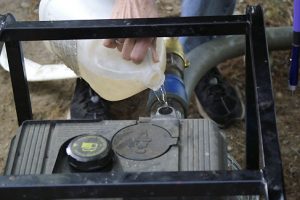
The pump must be primed with water before it can be started. Note gas filler cap in the foreground.
|
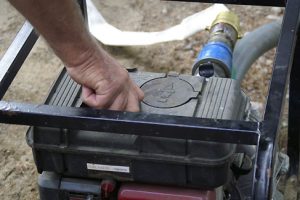
Gas level is checked before pump is started.
|
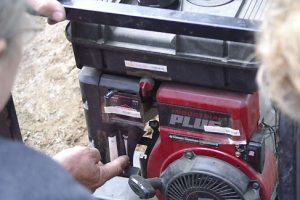
The controls for starting the pump are very similar to those found on a lawn mower or portable generator.
|
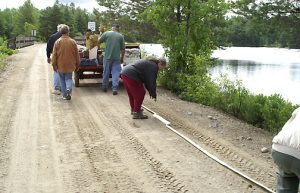
The equipment trailer is driven further down toward the bridge and firehose automatically drops from its storage area on the right side. “Students” check for kinks although the pressure of the water coming through the hose will ordinarily straighten it.
|
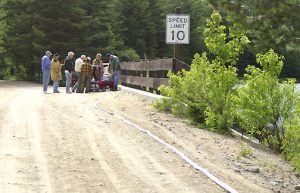
Pump #2 is set up on the bridge.
|
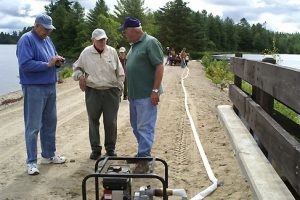
Pump #2 is in the foreground while the equipment trailer has been driven to the area where “students” will try their hand at handling the hose.
|
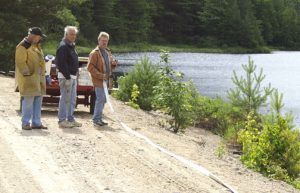
Preparing to connect the nozzle.
|
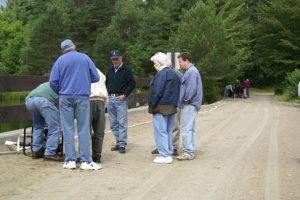
Pump #2 on the bridge. The crew at pump #1 can be seen in the background.
|
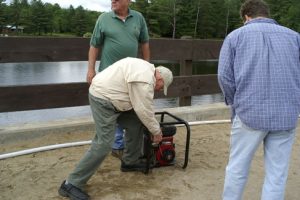
Al Larmann gives #2 a yank.
|
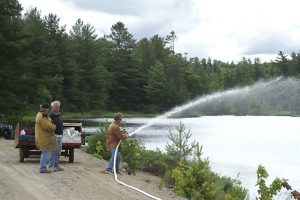
Success!
|

Mary Larmann gives it a try.
|

And then Ruth takes over. This is a pretty good view of the nozzle. The brass handle moves forward and back and is used to control the volume of water. The black nozzle end can be twisted to adjust the spray. A broad misting spray can put out more fire but doesn’t reach as far as a narrow stream.
|

It helps to have two people control the hose.
|
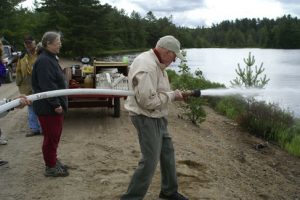
Al Larmann takes his turn.
|

Quite a distance!
|

Draining the hose by “walking” it.
|
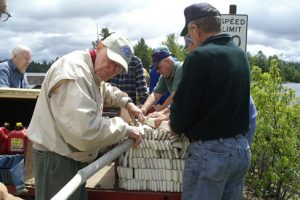
The fire hose is carefully flattened and folded back into place in the equipment trailer, so that in the event of an emergency it can be quickly laid out without tangles.
|

And finally, the trailer heads back to the fire barn. Note that pump #1 is last in, and therefore, first out.
|

























